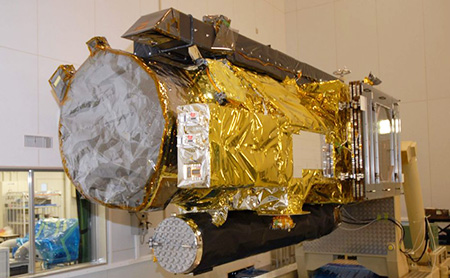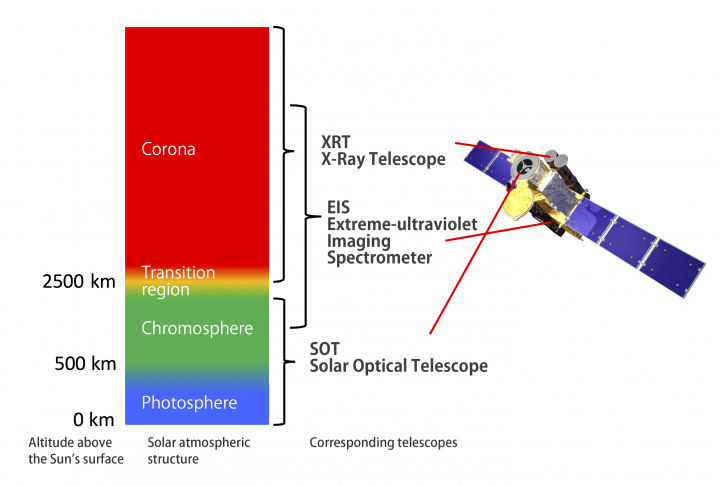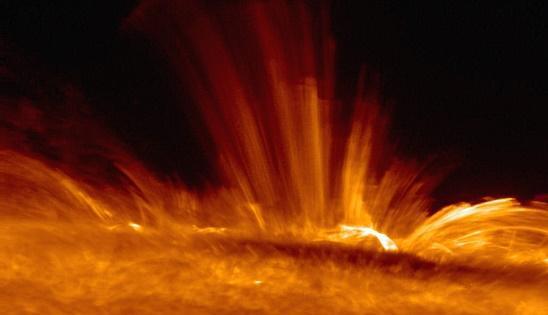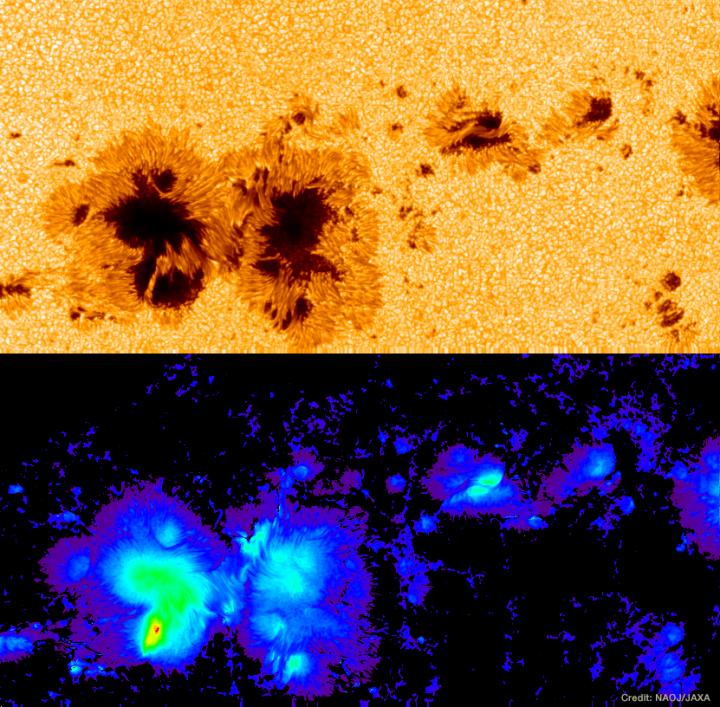
As the source of life giving energy, the Sun has a deeply engrained relationship with the Earth. Understanding how it works is an essential endeavour.
A ball of burning hydrogen and helium, the Sun contains a churning mass of charged material–called plasma–that spins magnetic fields, forms dark sunspots, and unleashes planet-shattering explosions as solar flares and coronal mass ejections (CMEs). This chaotic solar activity creates space weather and magnetic storms of superheated gas clouds that can slam into the Earth and disrupt electronics, navigation systems, and satellites.

Credit: JAXA
The only way to see the Sun’s corona is with ultraviolet and X-ray wavelengths; most of which are absorbed by the Earth’s atmosphere. Accordingly, space-based observatories orbiting above the Earth’s atmosphere are the best way to capture UV and X-ray images.
Hinode is an international mission led by JAXA, with participation from NASA, ESA, the United Kingdom Space Agency, and the National Astronomical Observatory of Japan. In accordance with Japanese tradition, Hinode’s name was changed from Solar-B after it launched in 2006. It built on the legacy of JAXA’s YOHKOH solar observatory (Solar-A).
 Credit: NAOJ
Credit: NAOJ
Hinode is equipped with three high-definition optical, EUV and X-ray instruments with enhanced large format detectors allowing heliophysics to study the solar magnetic field at scales smaller than previously attainable. Observing the wide temperature range of the solar atmosphere requires instruments sensitive to radiation over a broad range of wavelengths. Spectroscopic measurements are particularly important because they are used to determine plasma parameters such as temperature, density, and element abundance from measurements of the absolute intensities and intensity ratios of spectral lines. Additionally, the data is used to create high-precision vector magnetograms, Dopplergrams, and filtergrams with sub-arcsec resolution.

Credit: eoPortal
Investigating the Coronal Heating Problem
One of the biggest questions that Hinode set to answer is the “coronal heating problem”. The temperature of the solar surface (photosphere) is 6,000 K (~10,000 F) while the temperature of the outer corona is around 1,000,000 K (~1,800,000 F). This is contrary to common experience where the temperature decreases the further away from the heat source. It was known that magnetic fields were a major factor, however the specific mechanics remained a mystery.
Plasma travels along the magnetic lines generated in the solar dynamo. As those fields emerge past the surface of the Sun, they spread out into the atmosphere of the Sun in the corona. Spectroscopy observations of the emission lines emerging from the corona were performed with the Extreme-ultraviolet Imaging Spectrometer. The very high-resolution images captured by Hinode revealed tiny waves traveling along the magnetic lines of force. Known as Alfvén waves, the corona heats when the vertically oscillating wave energy is converted into thermal energy. The images taken by Hinode, along with data from NASA’s IRIS mission, enabled heliophysics to validate the wave heating theory.
Predicting Space Weather and the Solar Wind
Coronal heating and magnetic waves contribute to the acceleration of the solar wind, a continuous stream of electrically charged particles that fills the solar system with charged particles. This affects space weather which directly impacts the Earth.

Credit: NAOJ / JAXA
As the magnetic field lines interact with each other, they can trigger large explosions in the form of solar flares and CMEs, which hurl huge clouds of plasma into space at speeds of up to 7 million kilometres per hour. The Hinode Solar Optical Telescope enabled precise measurements of the magnetic field to verify the magnetic field structure that creates solar flares by comparing simulation models to actual observations. With further study, scientists hope to be able to accurately predict solar weather so we can respond to storms.
Hinode’s Extreme-ultraviolet Imaging Spectrometer also collected data on how magnetic reconnection can lead to the generation of solar flares. In magnetic reconnection, the energy stored in the magnetic field changes into heat and plasma motions, resulting in high-speed plasma flows. Magnetic reconnection may also contribute to low-speed solar wind.
Investigating Sunspots and Transient Horizontal Magnetic Fields
Sunspots are areas of concentrated magnetic fields formed when magnetic flux generated in the Sun’s core rises to the surface. The solar electrical current flows along the Sun's east-west rotation, generating magnetic fields that travel in a north-south direction. Since the rotational velocity is slower at the poles, it can stretch and twist these magnetic fields into sunspots.
 Snapshot of a sunspot observed by the Hinode spacecraft. Top: Visible light continuum image. Bottom: Magnetic field strength map. The color shows the field strength, from weak (cool colors) to strong (warm colors). Credit: NAOJ / JAXA
Snapshot of a sunspot observed by the Hinode spacecraft. Top: Visible light continuum image. Bottom: Magnetic field strength map. The color shows the field strength, from weak (cool colors) to strong (warm colors). Credit: NAOJ / JAXA
A sunspot usually consists of a circular dark core–the umbra–with a vertical magnetic field and radially elongated fine threads–the penumbra–with a horizontal field. Sunspots can be a source of plasma jets and explosions.
Additionally, Hinode discovered small scale magnetic fields know as Transient Horizontal Magnetic Fields. 30 to 100 times smaller than sunspots, these fields have short lifetimes of about four minutes, point horizontally along the solar surface, and exist across the entire surface of the Sun. Heliophysicists believe they maybe generated by a new dynamo mechanism in the convective zone below the surface of the Sun. These THMFs contain enough energy to heat the chromosphere and the corona.
Reversal of the Magnetic Poles
The magnetic field of the solar polar region is known to reverse every 11 years. This process corresponds with cycles of increased solar activity–solar maximum–with decreased levels–solar minimum. Researchers used data collected by Hinode to document that the north polar region of the Sun was changing significantly faster than the south pole. This surprising result may shift thinking around the bipolar structure of the sun where one pole is positive and the other is negative. Rather, the magnetic fields could form a quadrupole structure where both the north and south have positive polarity.
It is important to note that accurately imaging the poles is challenging because we have to observe the surface at an extremely oblique angle. Hinode's high resolution made it possible to conduct investigations using even oblique observations.
 Magnetic field strength distribution map of the solar south pole in April 2012. The blue dots represent north polarity, and the red dots represent south polarity. Credit: NAOJ / JAXA
Magnetic field strength distribution map of the solar south pole in April 2012. The blue dots represent north polarity, and the red dots represent south polarity. Credit: NAOJ / JAXA
